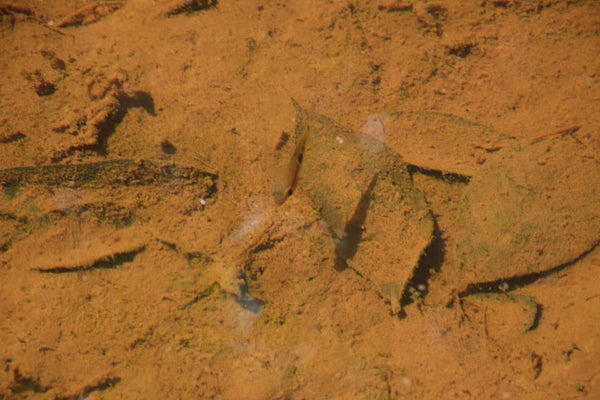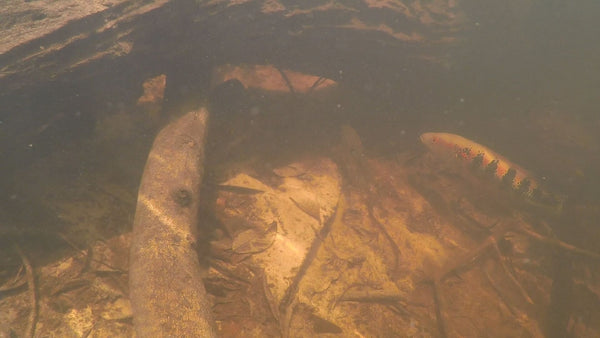- Continue Shopping
- Your Cart is Empty
Streams- in form and function.
As aquarists, it seems to me like little time is spent attempting to understand how and why the natural habitats evolve and function, and how we can utilize this information in our aquariums. I think it's a really interesting way to craft and maintain fantastic aquariums. Rather than looking to Nature just for the "look", we can actually model our aquariums after the way these systems function.

There are almost unlimited aquatic habitats to gain inspiration from!
If we focus on streams, which are one my personal areas of interest, there are some interesting takeaways for us as aquarists that we can gain by studying how they form and function. And, as with virtually all aquatic systems, the relationship between land and water is always impactful.
Much of how streams form and flow revolves around how sediments and other bottom materials arrive in them. It's important to note that the volume of water entering the stream helps, in part, to determine the amount and size of sediment particles that can be carried along, and thus comprise the substrate and its contours.

The composition of bottom materials and the depth of the channel are always changing in response to the flow in a given stream, affecting the composition and ecology in many ways. I'll probably state this idea more than once in this piece, because it's really important:
Every stream is unique. Although there are standard structural or functional elements common to many streams, each stream is essentially a "custom response" to local ecological, topographical, meteorological, and biological factors.

Permanent streams will often have different volume and material composition (usually finely-packed sands and gravels, with lots of smooth stones) than more intermittent streams, which are the result of inundation caused by rain, etc., or even so-called "ephemeral" streams, often packed with leaves and lighter sediments, which typically occur only immediately after rain events (which means they usually don't have fish in them unless they are washed into them from more permanent watercourses).

The latter two stream types are typically more affected by leaves, botanical debris, branches, and other materials. Like the igarapes ("canoe ways") of Brazil...little channels and rivulets which come and go with the seasonal rains. And then, there's those flooded Igapo forests we obsess over.

In the overall Amazon region (you knew I was sort of headed back that way, right?), it sort of works both ways, with the rivers influencing the surrounding land...and then the land "giving" some of the materials back to the rivers...the extensive lowland areas bordering the river and its tributaries, known as varzeas (“floodplains”), are subject to annual flooding, which helps foster enrichment of the aquatic environment.
Much of them come from trees.
Yeah, trees.
The materials that comprise the tree are known in ecology as "allochthonous material"- something imported into an ecosystem from outside of it. (extra points if you can pronounce the word on the first try...) And of course, in the case of trees, this also includes includes leaves, fruits and seed pods that fall or are washed into the water along with the branches and trunks that topple into the stream.
You know, the stuff we obsess over around here!

Although many streams derive their food base from leaves and organic matter, there is a lot of other material present that contributes to its structure. Think along those lines when scheming your next aquarium. Ask yourself what factors would contribute to the bottom composition of the area you're taking inspiration from.

Stream and river bottom composition is affected by things like regional weather, current, geology, the surrounding terrestrial ecosystem, and a host of other factors- all of which could make planning your next aquarium even more interesting if you take them into consideration!

And there is the whole dynamic of water movement. Like, what role does the flow of water determine the ecology of a given stream, and how it will "recruit" life forms to reside in it?
You'll see a variety of bottom compositions in Amazonian and other streams, ranging from the aforementioned leaves and detritus in stream margins, to sand and silt over "cobbles", to boulders covered in algae, to fine patch gravels, and even just silt.

You might even say that rivers and streams act like nature's "sediment sorting machines", as they move debris, geologic materials, and botanicals along their courses. And along the way, varying ecological communities are assembled, with all sorts of different fishes being attracted to different niches.

Interestingly, in streams, the primary producers of the food webs that attract our fishes are algae and diatoms, which are typically found on rocks and wood wherever light and nutrients create optimum conditions for their growth. Organic material that enters streams via leaf fall is acted upon by fungi and small organisms, which help break it down.
It is probably no surprise, then, that bacteria (especially in biofilms!) and fungi are the initial consumers of the organic materials that accumulate on the bottom. Like, the stuff many of us loathe. These, in turn, are extremely vital to fishes as a food source. Hence, one of the things I love so much about utilizing a leaf litter bed as a big part of your substrate composition in an aquarium! Of course, we talk about that all the time, right?

Streams which flow over stony, open bottoms, free from natural obstacles like tree trunks and such, tend to develop a rich algal turf on their surfaces.

While not something a lot of hobbyists like to see in their tanks (with the exception of Mbuna guys and weirdos like me), algae-covered stones and rocks are entirely natural and appropriate for the bottom of many aquariums! (enter a tank with THAT in the next international aquascaping contest and watch the ensuing judge "freak-out" it causes! )
Grazing fishes, of course, will feed extensively on or among these algal films, and would be logical choices for a stony-bottom-themed aquarium. When we think about the way natural fish communities are assembled in rivers and streams, it's almost always as a result of adaptations to the physical environment and food sources.

Now, not everyone wants to have algae-covered stones or a mass of decomposing leaves on the bottom of their aquarium. I totally get THAT! However, I think that considering the role that these materials play in the composition of streams and the lives of the fishes which inhabit them is important, and entirely consistent with our goal of creating the most natural, effective aquariums for the animals which we keep.
As a hobbyist, you can employ elements of these natural systems in a variety of aquariums, using any number of readily-available materials to do the job. And, let's face it; pretty much no matter how we 'scape a tank- no matter how much- or how little- thought and effort we put into it, our fishes will ultimately adapt to it.

They'll find the places they are comfortable hiding in. The places they like to forage, sleep and spawn. It doesn't matter if your 'scape consists of carefully selected roots, seed pods, rocks, plants, and driftwood, or simply a couple of clay flower pots and a few pieces of egg crate- your fishes will "make it work."

It's what fishes do. It's what they've done for eons.
Fishes tend to live in areas where the food and protection is, as we've talked about previously. Places that provide protection from stronger current, and above-and below-water predators. Places where they can create territories, interact, spawn and defend themselves.
Reduction of stress. Indeed, survival. That's pretty important in the wild...so I'd imagine it's equally as important in the aquarium.
In the end, design and build the aquascape that makes you happy.

However, if you're trying to create something a bit different and perhaps a bit more true to nature, you might want to take a little "field trip" to a nearby stream, river, creek, lake, etc., where fishes and other aquatic animals reside, and observe things from the perspective of how they interact with the features of the environment.

So, to recap, we go back to the streams of the tropical world.
They are amazing habitats for aquatic organisms to live in.
There is a reason why these environments are successful, why life exists- and indeed- thrives- in them. And there are reasons why we're starting to see incredible results when replicating some of the functional aspects of these environments in a more faithful manner than may have been attempted before.

Numerous questions remain to be answered. Tons of data to be accumulated. Setbacks to recover from. Triumphs to savor. Invaluable knowledge yet to be gained. Fun to be had.
And you're right in the thick of the hunt!
Stay bold. Stay firm. Stay focused. Stay open-minded. Stay resourceful. Stay creative...
And Stay Wet.
Scott Fellman
Tannin Aquatics






Scott Fellman
Author